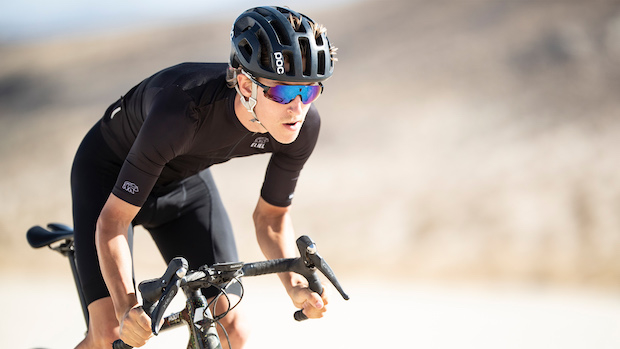Training with ENGO: Better Data For Specific Workouts

Most endurance athletes train wrong. This isn’t my opinion—it’s science. For example, a 2021 study appearing in the journal Sports reported that amateur triathletes who were tracked for six weeks leading up to an Olympic-distance race completed just 47 percent of their combined swimming, cycling, and running at low intensity, far below the recommended 80 percent.
The dividing line between low and moderate intensity falls at the first ventilatory threshold, which equates to around 80 percent of maximum heart rate. Athletes tend naturally swim, bike, and run just above this threshold in training sessions that they intend to do at low intensity, drifting ever so subtly over the line into moderate intensity. This is no big deal in a single workout, but when it becomes habitual—as it appears to be for the majority of athletes—the consequences snowball, with athletes carrying away a bit too much fatigue from each and every session, accruing a chronic burden of unresolved physiological stress that compromises performance in key workouts and stifles the body’s adaptations to training.
Real Time Data to the Rescue

As a coach, I make it my highest priority to correct such errors with each new athlete I bring on. Real-time training data is my best friend in this effort. In the bad old days, when the only metric athletes could track in real time during workouts was time itself, coaches just had to hope that athletes would execute correctly. Modern training devices have removed hope from the equation, functioning almost as surrogate in-person coaches that ensure their the athlete’s heart rate, power, and pace are where they should be and that segment distances and durations are precise.
Things have only gotten better with the advent of near-eye data displays as found in ENGO performance eyewear. Now, real-time training data is always within the athlete’s field of vision, available on command with only a slight shift in eye focus. With ENGO and similar products, heart rate, pace, power, and other data are essentially built into the training experience, similar to perception of effort and proprioception.
The mere availability of data does not guarantee effective use of that data, mind you. To get the most out of ENGO, athletes need guidance. Research indicates that endurance athletes move through different stages in their use of training devices—but not every athlete successfully graduates from one stage to the next. As a coach, I divide the process of mastering device usage into three stages:
Stage 1: Better Adherence to the “Letter” of Workouts
As I mentioned above, most endurance athletes make frequent errors in executing workouts. They set out intending to do one thing and end up doing something else, with unfortunate consequences. Near-eye displays of real-time data help athletes who struggle with adherence to execute workouts correctly. I’ll say more about this below.
Stage 2: Better Adherence to the “Spirit” of Workouts
The problem with planned workouts—as with all plans—is that they are essentially predictions, and predictions are seldom perfectly accurate. In these instances, I count on the athlete to understand and adhere to the spirit of the workout rather than to the letter.
Real-time data has a role to play at this second stage too, but it’s more nuanced. I’ll share my thoughts about how to use ENGO to ensure that the underlying purpose of each workout is met despite gaps between expectation and reality in part two of this series.
Stage 3: Better Self-Regulation of Training and Racing
The ultimate goal of every serious endurance athlete is to reach their full potential. Achieving this goal requires that the athlete become adept at self-regulation, or using internal feedback to find their absolute performance limit. That’s because the limit is kind of squishy in endurance sports—as much a matter of perception as of physiology.
I’ll share my thoughts on using ENGO in this third stage of device mastery in part three. The fourth and final installment in the series will address the special topic of using this new technology in competition.
Yes, But What Data

It’s easy to understand how continuous access to real-time data can help athletes better adhere to workout prescriptions. But there are many different types of data that might be used for this purpose, and they can’t all be equally useful in every situation. This is where coaching comes in. Athletes need to know which specific metrics to pay attention to when.
Following are examples of how I teach athletes to configure ENGO for three basic categories of workouts: low intensity (e.g., recovery runs, long rides), moderate intensity (e.g., tempo runs, critical power intervals), and high intensity (e.g., hill repetition runs, VO2max interval rides), along with my reasoning.
Note that ENGO allows athletes to configure three separate screens, which they can cycle through by waving a hand in front of the lenses. For now let’s focus on the primary screen configuration—we’ll look at other options in later installments of this four-part series.
Low-intensity Workouts
Data Field 1: Elapsed Time
Data Field 2: Distance
Data Field 3: Heart Rate
We’ve seen that endurance athletes often struggle to stay at low intensity in workouts they intend to do at low intensity. Better compliance in these training sessions requires that athletes hold themselves back. Heart rate is preferable to other intensity metrics for this purpose because it is not performance-relevant. Focusing on pace or power makes athletes want to push harder, but heart rate does not. To the extent that workouts are games, athletes feel they are “winning” when they are ahead of their pace and power targets, but with heart rate, “winning” means staying below a predetermined ceiling. For this reason, heart rate should have pride of place on your ENGO display in low-intensity workouts.
Moderate-intensity Workouts
Data Field 1: Lap Time
Data Field 2: Lap Distance
Data Field 3: Lap Pace/Power
Whereas in low-intensity training sessions your top priority is making sure you’re not pushing too hard, in moderate-intensity workouts it’s making sure you’re working hard enough (yet also not too hard). Performance measures—namely pace or power—therefore take the place of heart rate as the primary intensity metrics in your data screen configurations.
Time and distance information remain important in moderate-intensity workouts because they tell athletes where they are within session—how far they’ve come and how long they have to go. What matters more in moderate-intensity workouts, however, is not total elapsed time or distance covered but segmental (or “lap”) time/distance. For example, when you’re in the middle of a 20-minute tempo effort, you don’t care how deep you are into the entire workout, which perhaps started with a 15-minute warmup; you care only about how deep you are into those 20 minutes that really count.
Nor, for that matter, do you care about your average pace or power for the entire workout, including the warm-up. You want to know your average pace or power for the specific target range for the tempo segment you’re in the middle of, so you can thread the needle between too easy and too hard.

High-intensity Workouts
Data Field 1: Lap Time
Data Field 2: Lap Distance
Data Field 3: Cadence
I lied. I told you I was going to present the primary data screen configuration for each category of workout, but the example you see here is actually my recommended secondary screen for high-intensity workouts. That’s because the primary screen is the same for both moderate-intensity and high-intensity workouts.
The obvious difference between this configuration and the preceding is the presence of cadence. Why cadence? Because both stride rate in running and RPM on the bike are tightly coupled with intensity. When you’re hitting your target intensity in a high-intensity interval, your cadence will hover within a narrow range—until you start to fatigue and lose your form, at which point your cadence will begin to drop. I’ve found that by focusing on cadence as a supplement to pace or power in high-intensity workouts, athletes are better able to maintain their form as fatigue builds.
Looking Ahead
The guidelines I’ve provided here are not the last word on using products like ENGO to improve workout execution. But if you’re among the many athletes who struggle in this area, you should find them helpful. And if you’ve already mastered adherence to the letter of workouts, stay tuned; the next article in this series will discuss how to use near-eye displays of real-time data to adapt your workout execution on days when you feel better or worse than normal or when conditions are different than anticipated.
Editor's Note: This series of articles from Matt Fitzgerald will look at specific opportunities where real-time data can help you improve as an athlete. This series is part of our partnership with ENGO, and so you'll see mentions of their product throughout these pieces. However, these lessons are applicable to almost all athletes who wear some type of device during a workout. We hope you enjoy. To learn more about ENGO, click here.

